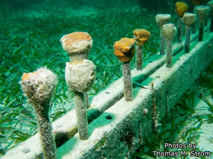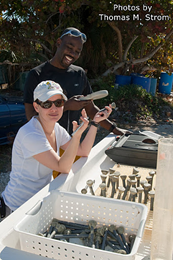Biscayne National Park’s Coral Nursery Club: working to protect Florida’s coral reefs
by Jonathan Dorsey, RJ Dunlap Marine Conservation Program intern
Biscayne National Park on the southeastern tip of Florida is 95% underwater. The bay consists of many types of coral species that may be in harm’s way. While these delicate reef structures struggle with warming waters, disease, and physical assaults from boaters, divers, and anglers, volunteers at the park are working to preserve them by designing coral nurseries.
The Coral Nursery Club was founded by the park rangers of Biscayne National Park in 1993. This is a non-profit organization that has three goals in mind: 1) To rescue coral fragments resulting from inadvertent vessel groundings in Park waters, 2) To develop and maintain a supply of natural coral colonies with a diversity that reflects natural conditions in the Park, and 3) To provide a platform for community volunteers to participate and learn the intricacies of coral reef management and restoration.
When the rangers hear of a boat grounding that took place in the bay, they take volunteers to go scavenge the reef for scraps for coral that were broken off or damaged. Using special adhesives, the rangers glue these coral fragments onto small spokes and further places into a long row underneath the dock at Adam’s Key. Then to monitor, the rangers take more volunteers out to photographing the collected samples, checking for growth and rejuvenation. By comparing these new pictures to the old ones, researchers are able to calculate the polyp growth rate and they take note of seasonal variances.
Unfortunately, the harsh winter weather was a little too much for one batch of coral, so all the specimen withered off. Focused on future survival of the corals, the rangers found a new place to raise the corals. This new location is none other than the University of Miami’s Experimental Hatchery, right across the street from the Rosenstiel School of Marine and Atmospheric Sciences. Here there are both indoor and outdoor facilities that can regulate and ideal water temperature for any time of the year.
The plus side to the new location is that the rangers don’t have to worry about the boat rides out to Adam’s Key and actually getting in the water. The waters at the dock are notoriously swift, and sometimes it caused for a struggle. The fast moving water, although carrying plenty of nutrients, caused for some stunt in the growth. Overall, the polyp counts are thriving in the artificial containers. As Richard Curry, a veteran coastal oceanographer of the park stated “The coral nursery research is giving us new insight about coral growth, reproduction, and the viability of re-seeding coral reefs. Our community volunteers are developing scientific processes that offer hope for coral reef recovery worldwide”
The efforts of all the rangers and volunteers is becoming more and more necessary given that more than 27% of the planet’s reefs are damaged and/ or dying due to disease, bleaching, climate changes or boat groundings. The Coral Nursery Club is a great organization that focuses on the restoration and enhancement of the local Biscayne National Park reefs.



Leave a Reply
Want to join the discussion?Feel free to contribute!